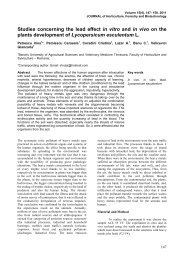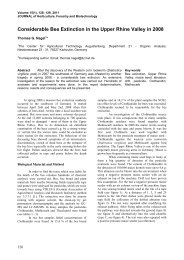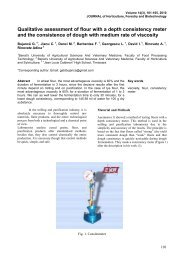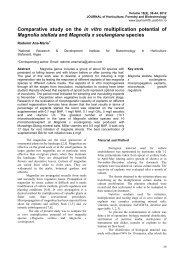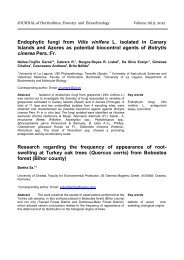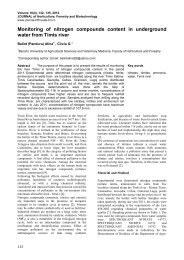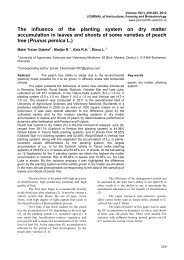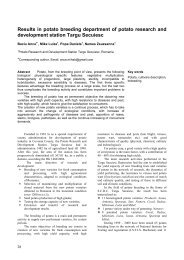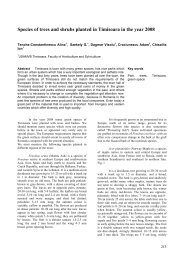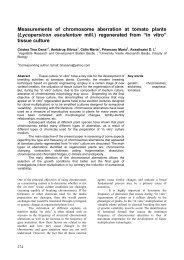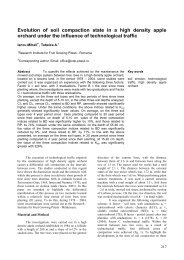In vitro culture initiation and phytohormonal influence on ornamental ...
In vitro culture initiation and phytohormonal influence on ornamental ...
In vitro culture initiation and phytohormonal influence on ornamental ...
Create successful ePaper yourself
Turn your PDF publications into a flip-book with our unique Google optimized e-Paper software.
Volume 16(2), 203-205, 2012JOURNAL of Horti<str<strong>on</strong>g>culture</str<strong>on</strong>g>, Forestry <str<strong>on</strong>g>and</str<strong>on</strong>g> Biotechnologywww.journal-hfb.usab-tm.ro<str<strong>on</strong>g>In</str<strong>on</strong>g> <str<strong>on</strong>g>vitro</str<strong>on</strong>g> <str<strong>on</strong>g>culture</str<strong>on</strong>g> <str<strong>on</strong>g>initiati<strong>on</strong></str<strong>on</strong>g> <str<strong>on</strong>g>and</str<strong>on</strong>g> <str<strong>on</strong>g>phytohorm<strong>on</strong>al</str<strong>on</strong>g> <str<strong>on</strong>g>influence</str<strong>on</strong>g> <strong>on</strong><strong>ornamental</strong> plantsLăpădătescu Sim<strong>on</strong>a 1 , Petolescu Cerasela 2 , Velicevici Giancarla 2 , Băla Maria 21 APIA Timişoara; 2 USAMVB Timişoara, Faculty of Horti<str<strong>on</strong>g>culture</str<strong>on</strong>g> <str<strong>on</strong>g>and</str<strong>on</strong>g> Sylvi<str<strong>on</strong>g>culture</str<strong>on</strong>g>*Corresp<strong>on</strong>ding author. e-mail: lapadatescusimo@yahoo.comAbstract The objective of this study was to evaluate the effect of differenttypes of growth regulators <str<strong>on</strong>g>and</str<strong>on</strong>g> their c<strong>on</strong>centrati<strong>on</strong>s <strong>on</strong> micropropagati<strong>on</strong> ofcarnati<strong>on</strong> axillary bud explants under in <str<strong>on</strong>g>vitro</str<strong>on</strong>g> c<strong>on</strong>diti<strong>on</strong>. The phytohorm<strong>on</strong>esshow significant <str<strong>on</strong>g>influence</str<strong>on</strong>g> <strong>on</strong> the process of plantlets neoformati<strong>on</strong> <str<strong>on</strong>g>and</str<strong>on</strong>g>rooting rate. Isolated axillary buds were <str<strong>on</strong>g>culture</str<strong>on</strong>g>d <strong>on</strong> MS mediumsupplemented with different levels of growth regulators <str<strong>on</strong>g>and</str<strong>on</strong>g> shootmultiplicati<strong>on</strong> rate were tested.Key wordsgrowth regulators, shootmultiplicati<strong>on</strong>, in <str<strong>on</strong>g>vitro</str<strong>on</strong>g><str<strong>on</strong>g>culture</str<strong>on</strong>g>, <strong>ornamental</strong> plantsOrnamental plants are produced mainly for theiraesthetic value; thus, the propagati<strong>on</strong> <str<strong>on</strong>g>and</str<strong>on</strong>g> improvementof quality attributes such as leaf types, flower colour<str<strong>on</strong>g>and</str<strong>on</strong>g> fragrance, l<strong>on</strong>gevity <str<strong>on</strong>g>and</str<strong>on</strong>g> form, plant shape <str<strong>on</strong>g>and</str<strong>on</strong>g>architecture, <str<strong>on</strong>g>and</str<strong>on</strong>g> the creati<strong>on</strong> of novel variati<strong>on</strong> areimportant ec<strong>on</strong>omic goals for the <strong>ornamental</strong> industry.Micropropagati<strong>on</strong> of <strong>ornamental</strong> plants is labouroriented,<str<strong>on</strong>g>and</str<strong>on</strong>g> for that reas<strong>on</strong>, outsourcing of plantmultiplicati<strong>on</strong> activities is shifted to the countrieshaving low labour cost. <str<strong>on</strong>g>In</str<strong>on</strong>g> spite of all these problems,in <str<strong>on</strong>g>vitro</str<strong>on</strong>g> propagati<strong>on</strong> of plants is still an efficient system<str<strong>on</strong>g>and</str<strong>on</strong>g> is being used by many commercial laboratories <str<strong>on</strong>g>and</str<strong>on</strong>g>nati<strong>on</strong>al institutes worldwide for rapid plantmultiplicati<strong>on</strong>, germplasm c<strong>on</strong>servati<strong>on</strong>, pathogeneliminati<strong>on</strong>, genetic manipulati<strong>on</strong>s, <str<strong>on</strong>g>and</str<strong>on</strong>g> for sec<strong>on</strong>darymetabolite producti<strong>on</strong>.Dianthus barbatus (turkish carnati<strong>on</strong>) is aspecies of carnati<strong>on</strong>s originating in the mountains ofsouthern Europe, with some varieties in north-easternChina <str<strong>on</strong>g>and</str<strong>on</strong>g> southern Russia. It is a herbaceous plant,biennial or perennial of short durati<strong>on</strong>, 30-75 cm high.Flowers, slightly scented, are arranged in a dense groupof up to 30 in number, in the upper stem.Plant tissue <str<strong>on</strong>g>culture</str<strong>on</strong>g> technique has been used inthis plant for virus eliminati<strong>on</strong>, commercialmicropropagati<strong>on</strong>, gene transformati<strong>on</strong> <str<strong>on</strong>g>and</str<strong>on</strong>g> inducti<strong>on</strong>of somacl<strong>on</strong>al variati<strong>on</strong> (1). Adventitious shootregenerati<strong>on</strong> in carnati<strong>on</strong> was affected by <str<strong>on</strong>g>culture</str<strong>on</strong>g>envir<strong>on</strong>ment, plant growth regulators <str<strong>on</strong>g>and</str<strong>on</strong>g> kind ofexplant (3,2,4). The comm<strong>on</strong>ly used explants wereaxillary buds <str<strong>on</strong>g>and</str<strong>on</strong>g> shoot tips (5). Regenerated shootsfrom axillary buds <str<strong>on</strong>g>and</str<strong>on</strong>g> shoot tips are true to typebecause in their regenerati<strong>on</strong> process there is no callusphase (1).The objective of this study was to evaluate theeffect of different types of growth regulators <str<strong>on</strong>g>and</str<strong>on</strong>g> theirc<strong>on</strong>centrati<strong>on</strong>s <strong>on</strong> micropropagati<strong>on</strong>, of carnati<strong>on</strong>axillary bud explants under in <str<strong>on</strong>g>vitro</str<strong>on</strong>g> c<strong>on</strong>diti<strong>on</strong>.Biological Material <str<strong>on</strong>g>and</str<strong>on</strong>g> MethodsSeed germinati<strong>on</strong> <str<strong>on</strong>g>and</str<strong>on</strong>g> seedling formati<strong>on</strong>. <str<strong>on</strong>g>In</str<strong>on</strong>g> <str<strong>on</strong>g>vitro</str<strong>on</strong>g><str<strong>on</strong>g>culture</str<strong>on</strong>g> was initiated with seeds of Dianthus barbathus.The seeds were washed with plenty of running water<str<strong>on</strong>g>and</str<strong>on</strong>g> then immersed in 20 % commercial bleach for 20min, rinsed with sterile distilled water <str<strong>on</strong>g>and</str<strong>on</strong>g> cultivated inPetri dishes (10 seeds per dish) c<strong>on</strong>taining sterile filterpaper with distilled water for germinati<strong>on</strong> under dark(10 days). N<strong>on</strong>-c<strong>on</strong>taminated germinated seeds, freedfrom seed coat, were transferred in new Petri dishesc<strong>on</strong>taining the MS 0 medium for seedlings formati<strong>on</strong><str<strong>on</strong>g>and</str<strong>on</strong>g> el<strong>on</strong>gati<strong>on</strong>. Biological material used in ourexperiences were represented by the microshootsharvested from chinese carnati<strong>on</strong> seedlings obtained byin <str<strong>on</strong>g>vitro</str<strong>on</strong>g> <str<strong>on</strong>g>culture</str<strong>on</strong>g> of seeds. Microshoots explantsharvested <str<strong>on</strong>g>and</str<strong>on</strong>g> inoculated <strong>on</strong> <str<strong>on</strong>g>culture</str<strong>on</strong>g> medium wereapical <str<strong>on</strong>g>and</str<strong>on</strong>g> nodal segments.Culture media. <str<strong>on</strong>g>In</str<strong>on</strong>g>itial apical <str<strong>on</strong>g>and</str<strong>on</strong>g> nodal segments(about 3-4 mm l<strong>on</strong>g) were cultivated <strong>on</strong> <strong>on</strong> the basicMS medium c<strong>on</strong>taining seven phytohorm<strong>on</strong>es: ANA ,2,4 D, AIA, AIB, BA, KIN, GA3 (0,5; 1,0; 1,5; 2,0; 2,5mg/l) for shoot inducti<strong>on</strong> <str<strong>on</strong>g>and</str<strong>on</strong>g> formati<strong>on</strong>. These shootswere sub<str<strong>on</strong>g>culture</str<strong>on</strong>g>d <strong>on</strong> the same medium. Another factorhas been experimentally studied: the combined effectof phytohorm<strong>on</strong>es <strong>on</strong> in <str<strong>on</strong>g>vitro</str<strong>on</strong>g> <str<strong>on</strong>g>culture</str<strong>on</strong>g> of carnati<strong>on</strong>:ANA/BA; ANA/KIN; 2.4-D/BA; 2,4-D/KIN;ANA/GA3. For each combinati<strong>on</strong> auxins/citokininsrespectively auxins/gibberellines were analyzedfollowing c<strong>on</strong>centrati<strong>on</strong>s of phytohorm<strong>on</strong>es: 0,5/0,5;1,5/0,5; 2,0/1,0; 2,5/1,0; 2,5/2,5.Results <str<strong>on</strong>g>and</str<strong>on</strong>g> Discussi<strong>on</strong>sAt Dianthus barbatus <str<strong>on</strong>g>and</str<strong>on</strong>g> all sources of variati<strong>on</strong>,phytohorm<strong>on</strong>es, respectively their c<strong>on</strong>centrati<strong>on</strong>s <str<strong>on</strong>g>and</str<strong>on</strong>g>their combined effect has a significant <str<strong>on</strong>g>influence</str<strong>on</strong>g> <strong>on</strong>plantlets neoformati<strong>on</strong> in this species.203
Regarding the interacti<strong>on</strong> betweenphytohorm<strong>on</strong>es <str<strong>on</strong>g>and</str<strong>on</strong>g> c<strong>on</strong>centrati<strong>on</strong>s, plantletsneoformati<strong>on</strong> showed values between 41,90 to GA3 1mg/l <str<strong>on</strong>g>and</str<strong>on</strong>g> 89% for ANA 2,5 mg/l, at a high amplitude of48,10%. For alpha naphtaleneacetic acid c<strong>on</strong>centrati<strong>on</strong>of 2,5 mg/l enable it to obtain a significantly higherpercent of plantelets neoformati<strong>on</strong> than the valuesrecorded at the other c<strong>on</strong>centrati<strong>on</strong>s. Use of 2,4-D acid,statistically assured there were differences <strong>on</strong>lybetween results obtained at c<strong>on</strong>centrati<strong>on</strong> of 2,5 <str<strong>on</strong>g>and</str<strong>on</strong>g>0,5 mg/l (table 1).Effect of phytohorm<strong>on</strong>es <str<strong>on</strong>g>and</str<strong>on</strong>g> c<strong>on</strong>centrati<strong>on</strong>s <strong>on</strong> plantlets neoformati<strong>on</strong> rateNr.C<strong>on</strong>centrati<strong>on</strong> (mg/l)Phytohorm<strong>on</strong>escrt 0,5 1,0 1,5 2,0 2,51 ANA 72,53a 76,13a 74,70ab 82,40a 89,00a2 2,4 D 72,30a 73,70a 78,67a 82,03a 85,90a3 AIA 70,60a 68,80a 70,83ab 75,10a 76,90ab4 AIB 62,73a 68,40a 70,23a 58,53b 64,93b5 BA 66,53a 64,07a 62,87b 64,00b 68,07b6 KIN 67,27a 67,60a 69,10ab 67,20b 69,03b7 GA3 42,80b 41,90b 43,60c 42,40c 43,77cDL 5% =12,22 DL 1% =16,23 DL 0,1% =21,05Table 1When using alpha indolilacetic acid, amino isobutyricacid, benzilaminopurine, kinetine <str<strong>on</strong>g>and</str<strong>on</strong>g> giberellic acidc<strong>on</strong>centrati<strong>on</strong> did not <str<strong>on</strong>g>influence</str<strong>on</strong>g> significantly thepercentage of shoots neoformati<strong>on</strong> to D. barbatus.Regarding the effect of combinati<strong>on</strong>s ofphytohorm<strong>on</strong>es <str<strong>on</strong>g>and</str<strong>on</strong>g> their c<strong>on</strong>centrati<strong>on</strong>s <strong>on</strong> the shootsneoformati<strong>on</strong> from Dianthus barbatus, is noted thatstatistically assured there are real differences betweenboth unilateral effects of these factors combined, whilethe variati<strong>on</strong> was very low due explants.Effect of phytohorm<strong>on</strong>es combinati<strong>on</strong>s <str<strong>on</strong>g>and</str<strong>on</strong>g> c<strong>on</strong>centrati<strong>on</strong>s <strong>on</strong> plantlets neoformati<strong>on</strong> rateNr. Phytohorm<strong>on</strong>es C<strong>on</strong>centrati<strong>on</strong>(mg/l)crt combinati<strong>on</strong> 0,5/0,5 1,5/0,5 2,0/1,0 2,5/1,0 2,5/2,51 ANA/BA 80,47 83,23ab 91,87 93,13a 90,002 ANA/KIN 82,97 85,53a 85,37 91,77ab 94,403 2,4 D/BA 73,53 72,63b 83,73 81,37b 89,034 2,4 D/KIN 77,10 84,17ab 87,77 91,70ab 91,535 ANA/GA3 77,93 82,77ab 82,60 82,20ab 83,27DL 5% =11,65 DL 1% =15,55 DL 0,1% =20,32Table 2Regarding the interacti<strong>on</strong> between combinati<strong>on</strong>s <str<strong>on</strong>g>and</str<strong>on</strong>g>c<strong>on</strong>centrati<strong>on</strong>s of phytohorm<strong>on</strong>es in Diantus barbatusshoots neoformati<strong>on</strong> were recorded range from 72,63to versi<strong>on</strong> 2,4-D/BA - 0,5/0,5 mg/l <str<strong>on</strong>g>and</str<strong>on</strong>g> 93,13% forANA/BA - 2,5/1,0 mg/l, at a 20,50% amplitude. Atc<strong>on</strong>centrati<strong>on</strong>s of 0,5/0,5; 2,0/1,0 <str<strong>on</strong>g>and</str<strong>on</strong>g> 2,5/2,5, nosignificant differences occurred between combinati<strong>on</strong>sof phytohorm<strong>on</strong>es in terms of their effect <strong>on</strong> shootsneoformati<strong>on</strong> percentage (table 2).Regarding the combined effect ofphytohorm<strong>on</strong>es <str<strong>on</strong>g>and</str<strong>on</strong>g> their c<strong>on</strong>centrati<strong>on</strong>s <strong>on</strong> plantletsrooting of D. barbatus, the results showed a wideamplitude of 2,77 with limits ranging from 25,83 forthe combinati<strong>on</strong> 2,5 mg/l KIN to 89,17% thecombinati<strong>on</strong> 2 mg/l GA3.Taking into account the effect ofphytohorm<strong>on</strong>es at various c<strong>on</strong>centrati<strong>on</strong>s, it appearsthat whatever the c<strong>on</strong>centrati<strong>on</strong> used, citokinine had asignificant lower effect than other horm<strong>on</strong>es in termsof rate of plantlets rooting. Lowest variability betweenhorm<strong>on</strong>e c<strong>on</strong>centrati<strong>on</strong> was recorded at 0,5 mg/l whilethe c<strong>on</strong>centrati<strong>on</strong> of 2,0 mg/l occurred largestdeviati<strong>on</strong>s between the effects of phytohorm<strong>on</strong>es <strong>on</strong>the process of rooting (table 3).Given the cumulative effect of phytohorm<strong>on</strong>es <str<strong>on</strong>g>and</str<strong>on</strong>g>c<strong>on</strong>centrati<strong>on</strong>s of different combinati<strong>on</strong>s, plantletsrooting rate for D. barbatus showed values rangingfrom 36% for the combinati<strong>on</strong> 2,4-D/BA at a combinedc<strong>on</strong>centrati<strong>on</strong> of 1,5 mg/l <str<strong>on</strong>g>and</str<strong>on</strong>g> 96,60% for combinati<strong>on</strong>ANA/GA3 at the total c<strong>on</strong>centrati<strong>on</strong> of 5 mg/l, at avery high amplitude of 60,60%.204
Effect of phytohorm<strong>on</strong>es <str<strong>on</strong>g>and</str<strong>on</strong>g> c<strong>on</strong>centrati<strong>on</strong>s <strong>on</strong> plantlets rooting rateNr.C<strong>on</strong>centrati<strong>on</strong> (mg/l)Phytohorm<strong>on</strong>escrt 0,5 1,0 1,5 2,0 2,51 ANA 85,70a 88,23a 84,93a 87,80a 88,73a2 2,4 D 77,93a 77,13ab 79,87ab 80,00ab 81,43ab3 AIA 74,83a 84,27a 56,73cd 82,40a 62,33bc4 AIB 44,47b 58,03bc 63,70bc 60,37b 60,40cd5 BA 50,60b 39,77c 40,87de 39,33c 42,07de6 KIN 38,37b 45,57c 29,90e 28,00c 25,83e7 GA3 79,90a 84,70a 82,43ab 89,17a 88,30aDL5%=20,44 DL1%=27,17 DL0,1%=35,23Effect of phytohorm<strong>on</strong>es combinati<strong>on</strong>s <str<strong>on</strong>g>and</str<strong>on</strong>g> c<strong>on</strong>centrati<strong>on</strong>s <strong>on</strong> plantlets rooting rateNr. Phytohorm<strong>on</strong>esC<strong>on</strong>centrati<strong>on</strong> (mg/l)crt combinati<strong>on</strong> 0,5/0,5 1,5/0,5 2,0/1,0 2,5/1,0 2,5/2,51 ANA/BA 47,57c 57,63bc 58,97b 63,60b 74,23b2 ANA/KIN 69,53b 71,27b 61,90b 69,97b 65,77bc3 2,4 D/BA 40,30c 37,23d 36,00c 36,40c 41,47d4 2,4 D/KIN 43,67c 48,67cd 49,60bc 41,47c 47,17cd5 ANA/GA3 93,83a 92,30a 92,83a 95,40a 96,60aDL5%=19,79 DL1%=26,40 DL0,1%=34,50Changing horm<strong>on</strong>al balance for the combinati<strong>on</strong>s ofphytohorm<strong>on</strong>es had a major <str<strong>on</strong>g>influence</str<strong>on</strong>g>, significant <strong>on</strong>rooting process. The highest differences betweencombinati<strong>on</strong>s of phytohorm<strong>on</strong>es is observed atc<strong>on</strong>centrati<strong>on</strong>s of 1 mg/l <str<strong>on</strong>g>and</str<strong>on</strong>g> the lowest deviati<strong>on</strong>s atthe c<strong>on</strong>centrati<strong>on</strong> of 5 mg/l (table 4).C<strong>on</strong>clusi<strong>on</strong>sAt Dianthus barbatus <str<strong>on</strong>g>and</str<strong>on</strong>g> all sources ofvariati<strong>on</strong>, phytohorm<strong>on</strong>es, respectively theirc<strong>on</strong>centrati<strong>on</strong>s <str<strong>on</strong>g>and</str<strong>on</strong>g> their combined effect has asignificant <str<strong>on</strong>g>influence</str<strong>on</strong>g> <strong>on</strong> plantlets neoformati<strong>on</strong> in thisspecies, occurring differences statistically assured.Regarding the interacti<strong>on</strong> between phytohorm<strong>on</strong>es <str<strong>on</strong>g>and</str<strong>on</strong>g>c<strong>on</strong>centrati<strong>on</strong>s, plantlets neoformati<strong>on</strong> showed valuesbetween 41,90 to GA3 1 mg/l <str<strong>on</strong>g>and</str<strong>on</strong>g> 89% for ANA 2,5mg/l, at a high amplitude of 48,10%. Regarding theeffect of combinati<strong>on</strong>s of phytohorm<strong>on</strong>es <str<strong>on</strong>g>and</str<strong>on</strong>g> theirc<strong>on</strong>centrati<strong>on</strong>s <strong>on</strong> the shoots neoformati<strong>on</strong> fromDianthus barbatus, is noted that statistically assuredthere are real differences between both unilateraleffects of these factors combined, while the variati<strong>on</strong>was very low due explants.Given the cumulative effect of phytohorm<strong>on</strong>es<str<strong>on</strong>g>and</str<strong>on</strong>g> c<strong>on</strong>centrati<strong>on</strong>s of different combinati<strong>on</strong>s, plantletsrooting rate for D. barbatus showed values rangingfrom 36% for the combinati<strong>on</strong> 2,4-D/BA at a combinedc<strong>on</strong>centrati<strong>on</strong> of 1,5 mg/l <str<strong>on</strong>g>and</str<strong>on</strong>g> 96,60% for combinati<strong>on</strong>ANA/GA3 at the total c<strong>on</strong>centrati<strong>on</strong> of 5 mg/l, at avery high amplitude of 60,60%.Changing horm<strong>on</strong>al balance for thecombinati<strong>on</strong>s of phytohorm<strong>on</strong>es had a major <str<strong>on</strong>g>influence</str<strong>on</strong>g>,significant <strong>on</strong> rooting process. The highest differencesbetween combinati<strong>on</strong>s of phytohorm<strong>on</strong>es is observed atTable 3Table 4c<strong>on</strong>centrati<strong>on</strong>s of 1 mg/l <str<strong>on</strong>g>and</str<strong>on</strong>g> the lowest deviati<strong>on</strong>s atthe c<strong>on</strong>centrati<strong>on</strong> of 5 mg/l.AcknowledgementThis work was published during the project“POSTDOCTORAL SCHOOL OF AGRICULTUREAND VETERINARY MEDICINE",POSDRU/89/1.5/S/62371, co-financed by theEuropean Social Fund through the SectorialOperati<strong>on</strong>al Programme for the Human ResourcesDevelopment 2007-2013.References1. Brar MS, Al-khayri M, <str<strong>on</strong>g>and</str<strong>on</strong>g> Klingaman GL (1995).Effect of thidiazur<strong>on</strong> <str<strong>on</strong>g>and</str<strong>on</strong>g> benzylaminopurine <strong>on</strong> in<str<strong>on</strong>g>vitro</str<strong>on</strong>g> shoot proliferati<strong>on</strong> of carnati<strong>on</strong> (Dianthuscaryophyllus L.). Proc. Arkansas Academy Sci. 49: 30-33.2. Casanova E, Moysset L, <str<strong>on</strong>g>and</str<strong>on</strong>g> Trillas MI (2008).Effect of agar c<strong>on</strong>centrati<strong>on</strong> <str<strong>on</strong>g>and</str<strong>on</strong>g> vessel closure <strong>on</strong> theorganogenesis <str<strong>on</strong>g>and</str<strong>on</strong>g> hyperhydricity of adventitiouscarnati<strong>on</strong> shoots. Biol. Plantarum. 52(1): 1-83. Kanwar JK <str<strong>on</strong>g>and</str<strong>on</strong>g> Kumar S (2009). <str<strong>on</strong>g>In</str<strong>on</strong>g>fluence ofgrowth regulators <str<strong>on</strong>g>and</str<strong>on</strong>g> explants <strong>on</strong> shoot regenerati<strong>on</strong> incarnati<strong>on</strong>. Hort. Sci. 36: 140-146,4. Pareek A, Kantia A, <str<strong>on</strong>g>and</str<strong>on</strong>g> Kothari SL (2004). <str<strong>on</strong>g>In</str<strong>on</strong>g> <str<strong>on</strong>g>vitro</str<strong>on</strong>g>cl<strong>on</strong>ing of <strong>ornamental</strong> species of Dianthus. <str<strong>on</strong>g>In</str<strong>on</strong>g>dian J.Biotechnol. 3: 263-266.5. Salehi 2006 Salehi H (2006). Can a general shootproliferati<strong>on</strong> <str<strong>on</strong>g>and</str<strong>on</strong>g> rooting medium be used for a numberof carnati<strong>on</strong> cultivars?. Afr. J. Biotechnol. 5: 25-30.205



